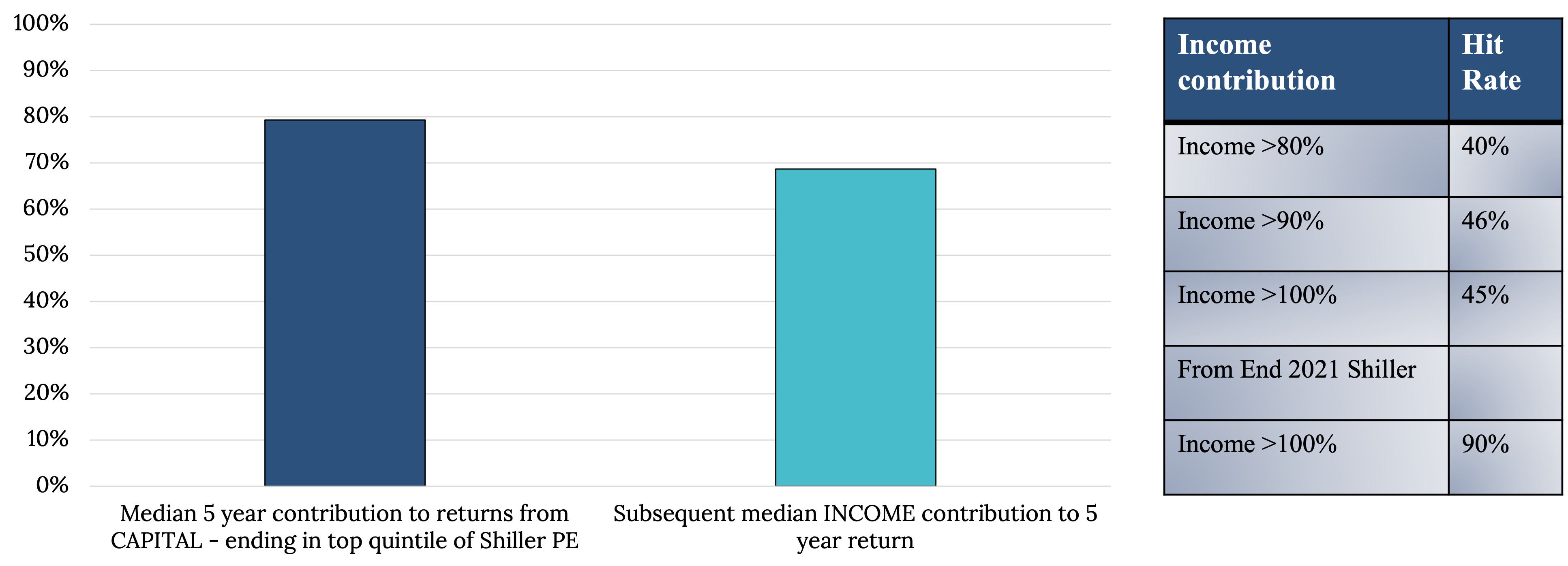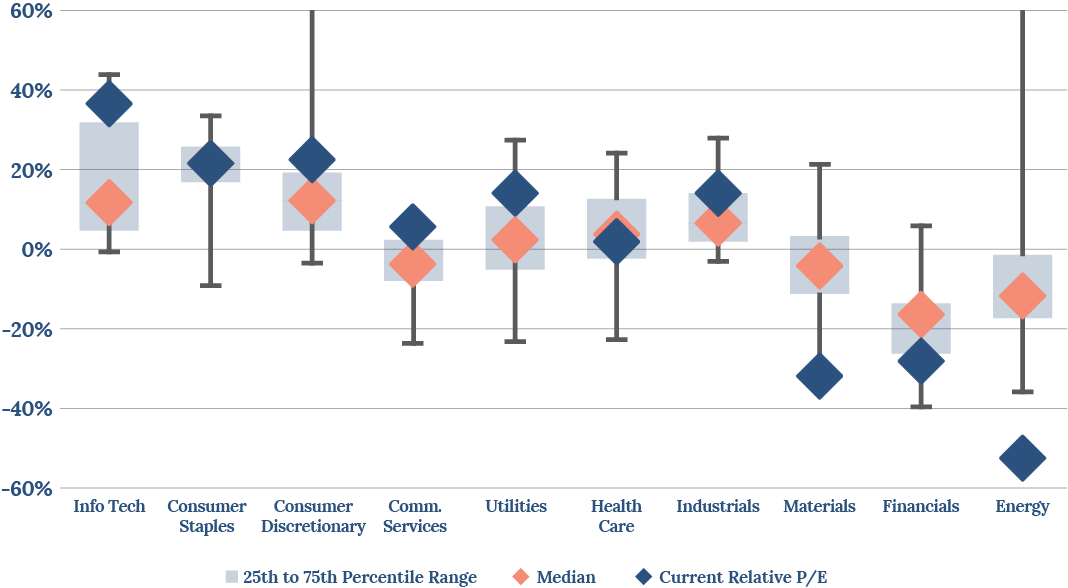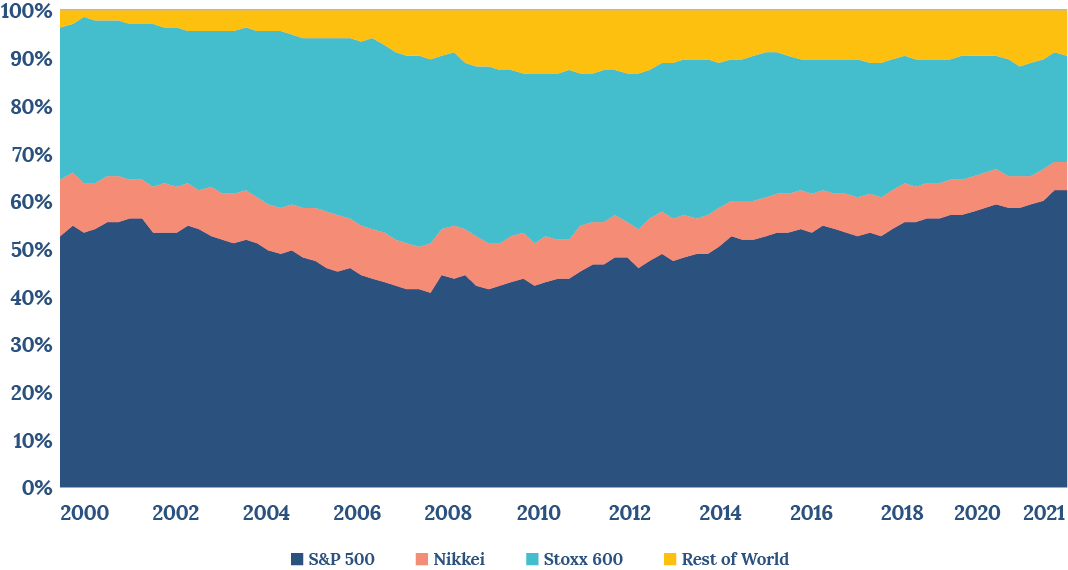“Diversification is the only free lunch”
Last time I wrote about the current challenge for investors in the face of the potential combination of rising interest rates and falling growth, especially as so many are positioned for the recent past to continue. While it has been a fundamental tenet of portfolio construction for decades, a different version of diversification is particularly pertinent in current market conditions, so today I want to discuss what that looks like and why it makes so much sense now.
1. Income or “I like those odds”
At the risk of stating the obvious, total return from equities comprises two elements: capital growth and income. We find it hard to over-emphasise the importance of income at this juncture. Investors focused on the stellar capital component of returns may find income easy to dismiss. However, the data are clear.
Looking at the US equity market, long-term contributions to total return have been neck-and-neck, 49% income to 51% growth. It is true that over the shorter term, the mix ebbs and flows but the lesson is that the income component contributes considerably more when the starting valuation of equities is relatively high, as is the case today.
The chart below shows the capital contribution on a 5-year basis when the market ends at a Shiller P/e in the most expensive quintile. Unsurprisingly when multiples end in the most expensive quintile – more of the return than average is due to capital growth, but income then dominates returns over the next 5 years. Indeed, the median contribution from income over the next 5 years is 69%. More sobering is the fact that 45% of the time more than 100% of the return to equity investors comes from income.
The crucial role of income

To the end of 2021 capital had contributed 90% of total returns in the prior 5 years, a level only exceeded 2% of the time going back to 1876. From this starting point the prognosis for income as a component of total return is startling - in the subsequent 5 years more than 100% of returns has come from income 90% of the time.
Given the above – investors should lean into income and away from capital growth. This does not just mean gaining exposure to dividends. It also means using all sources of income available including option premium – as it can generate materially higher income and unlike dividend funds, suffers less in market drawdowns, is not subjected to sector concentration risks, and doesn’t suffer from the fact that equity dividends are at management and the Board of Director’s discretion.
2. Style and Sector
Although we are bottom-up investors and sector agnostic, an understanding of sentiment, positioning and valuation informs our investment process.
The PE relative chart below shows what areas are in or out of favour versus the market and the past. A number of the sectors that have high correlation with fixed income, the so-called bond proxies, look expensive: Tech, Consumer Discretionary, Communication Services and Utilities. Given the move in Treasuries and the concerns over inflation, this is somewhat surprising.
At the other end of the scale, Materials, Financials and Energy offer good value and diversification.
Current Sector Forward P/E Premium (Discount) Since 2005

Source: Bloomberg, S&P Dow Jones Indices
One of the outstanding opportunities is in Health Care, which is a non-cyclical sector actually trading cheap versus the past. This is not its only attraction.
StateStreet Advisors provides information on client holdings and, according to its data, Health Care is the second most underweight sector after Real Estate as well as having defensive characteristics. For example, it has not experienced a down year of earnings' forecasts going back as far as 1996.
3. Region
On a regional basis, the only equities’ game in town since the GFC has been US stocks. This may be to exaggerate for effect, but it’s clearly not a million miles from the truth, as the chart below illustrates.
US Dominates Globally

In terms of valuation, the US now trades at a material premium to global indices. There may be good reasons for this, but they don’t change the maths underlying prospective returns. On a PER of 19.8, the S&P offers an earnings’ yield of just under 5.0% compared to just under 6.0% for Europe and 6.5% for Japan. These may seem marginal differences but over time a 14% discount to the US for Europe and a 24% discount for Japan are meaningful.
At what is a difficult time in the world and in financial markets, our key message remains that most investors are positioned for a resumption of the status quo: a return to a world of low inflation, low interest rates and moderate growth.
Even if these expectations prove to be correct, high equity valuations in the US and Tech mean that the outlook is poor for long-run returns in the two areas that have dominated performance and portfolios since the GFC. Furthermore, on the way to this posited benign future, markets are having to negotiate a rare and dangerous combination of Fed tightening into a weakening economy. This is a serious challenge.
The necessary and best solution is to diversify. This means embracing income as a component of return, value as a factor, regions other than the US and sectors other than Tech. Doing this will by definition reduce the concentration risk to which so many investors are exposed. It will also increase alignment to areas of the market that promise meaningful upside, and offer investors that well earned free lunch.
Stay up to date with all our latest wires
Hit the 'follow' button below and you'll be notified every time we post content on Livewire.
5 topics

